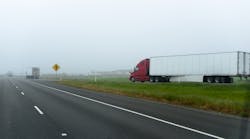A group of Republican senators is trying to overturn the U.S. Environmental Protection Agency’s more stringent emissions rules for heavy-duty truck and engine manufacturers.
Led by Sen. Deb Fischer (R-Nebraska), 34 senators introduced legislation on Feb. 9 to overturn the new EPA rule that goes into effect for model year 2027 commercial vehicles. The Congressional Review Act resolution was first reported by The Hill.
The review act allows a simple majority in both chambers to overturn the executive branch action, such as federal rulemaking. While the GOP has a majority in the U.S. House, the Democrats have a two-member advantage in the Senate.
“This aggressive EPA rule—which will hit mom-and-pop truck operations the hardest—is also ineffective because it incentivizes operators to keep using older, higher-emitting trucks for longer,” Fischer said in an issued statement. “During a period of high inflation and supply chain disruptions, the last thing this country needs is more expensive freight costs and fewer truckers. I am proud to be leading a large coalition of my colleagues to push back against the Biden Administration’s obsession with excessive climate regulations.”
Fischer argues the EPA rule would make trucking more expensive in the U.S.
“We appreciate the attention Sen. Fischer’s proposal brings to the real issues surrounding the regulation of heavy-duty truck emissions," Sean McNally, American Trucking Associations' VP of public affairs, told FleetOwner. "ATA is committed to working with our champions in Congress, coalition partners in industry, and federal regulators to ensure we have an achievable and realistic national framework that results in meaningful reductions in emissions.”
EPA’s Clean Truck Plan
After announcing the new emissions rules in December, the EPA finalized regulations in January. They would become official in late March, giving OEMs less than four years to apply the rules to heavy-duty trucks and engines by model year 2027.
To reduce air pollution—including pollutants that create ozone and particulate matter—from large trucks, emission reductions will increase over time as more new, cleaner vehicles enter the market, according to the EPA.
"We estimate that the final rule will reduce [NOx] emissions from heavy-duty vehicles in 2040 by more than 40%; by 2045, a year by which most of the regulated fleet will have turned over, heavy-duty NOX emissions will be almost 50% lower than they would have been without this action," according to an EPA summary within the final rulemaking.
The heavy-duty commercial vehicle requirements will limit NOx emissions to 0.035 grams per horsepower-hour during regular operation, 0.050 grams at low load, and 10 grams at idle. According to the latest regulations, warranties would be extended from 100,000 miles to 450,000 miles, and the useful life of a covered commercial vehicle from 435,000 miles to 650,000 miles.
The new rules are the first part of EPA's three-step Clean Truck Plan, which will be followed by the proposed Phase 3 GHG standards for heavy-duty vehicles also beginning in model year 2027 and multipollutant standards for light- and medium-duty vehicles starting with that same model year.
The final EPA commercial vehicle regulation includes new, more stringent emissions standards covering a more comprehensive range of heavy-duty engine operating conditions than today's standards. According to an EPA rule summary published on its website, these stricter emissions standards must be met for a longer time when these engines operate on the road.
In statements accompanying Fischer’s press release on the legislation, the Owner-Operator Independent Drivers Association said the EPA’s more stringent rules lead smaller fleets and independent drivers to keep running older equipment.
“The prior years of over-ambitious emission standards have already created unreliable equipment for many years and even driven one of the primary engine manufacturers out of the on-road industry,” said Danny Schnautz, president of Texas-based Clark Freight Lines, in a statement issued by Fischer’s office. “These ongoing emission systems failures are devastating.”




